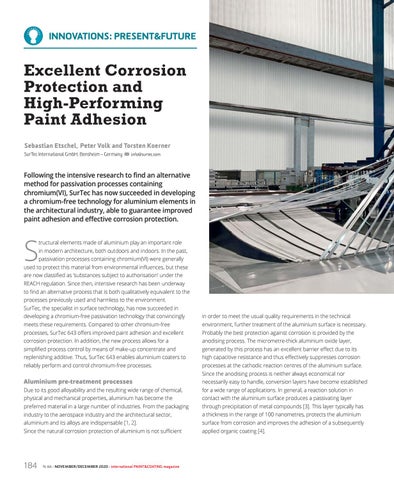INNOVATIONS: PRESENT&FUTURE
Excellent Corrosion Protection and High-Performing Paint Adhesion Sebastian Etschel, Peter Volk and Torsten Koerner SurTec International GmbH, Bensheim – Germany
info@surtec.com
Following the intensive research to find an alternative method for passivation processes containing chromium(VI), SurTec has now succeeded in developing a chromium-free technology for aluminium elements in the architectural industry, able to guarantee improved paint adhesion and effective corrosion protection.
S
tructural elements made of aluminium play an important role in modern architecture, both outdoors and indoors. In the past, passivation processes containing chromium(VI) were generally
used to protect this material from environmental influences, but these are now classified as ‘substances subject to authorisation’ under the REACH regulation. Since then, intensive research has been underway to find an alternative process that is both qualitatively equivalent to the processes previously used and harmless to the environment. SurTec, the specialist in surface technology, has now succeeded in developing a chromium-free passivation technology that convincingly
in order to meet the usual quality requirements in the technical
meets these requirements. Compared to other chromium-free
environment, further treatment of the aluminium surface is necessary.
processes, SurTec 643 offers improved paint adhesion and excellent
Probably the best protection against corrosion is provided by the
corrosion protection. In addition, the new process allows for a
anodising process. The micrometre-thick aluminium oxide layer,
simplified process control by means of make-up concentrate and
generated by this process has an excellent barrier effect due to its
replenishing additive. Thus, SurTec 643 enables aluminium coaters to
high capacitive resistance and thus effectively suppresses corrosion
reliably perform and control chromium-free processes.
processes at the cathodic reaction centres of the aluminium surface. Since the anodising process is neither always economical nor
Aluminium pre-treatment processes
necessarily easy to handle, conversion layers have become established
Due to its good alloyability and the resulting wide range of chemical,
for a wide range of applications. In general, a reaction solution in
physical and mechanical properties, aluminium has become the
contact with the aluminium surface produces a passivating layer
preferred material in a large number of industries. From the packaging
through precipitation of metal compounds [3]. This layer typically has
industry to the aerospace industry and the architectural sector,
a thickness in the range of 100 nanometres, protects the aluminium
aluminium and its alloys are indispensable [1, 2].
surface from corrosion and improves the adhesion of a subsequently
Since the natural corrosion protection of aluminium is not sufficient
applied organic coating [4].
184
N. 66 - NOVEMBER/DECEMBER 2020 - international PAINT&COATING magazine
